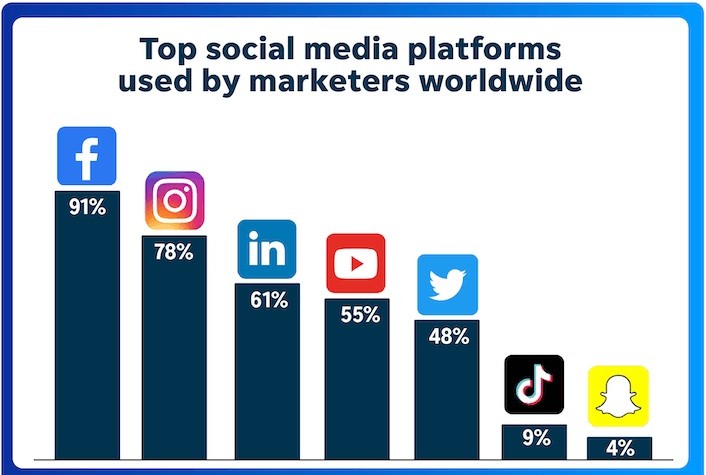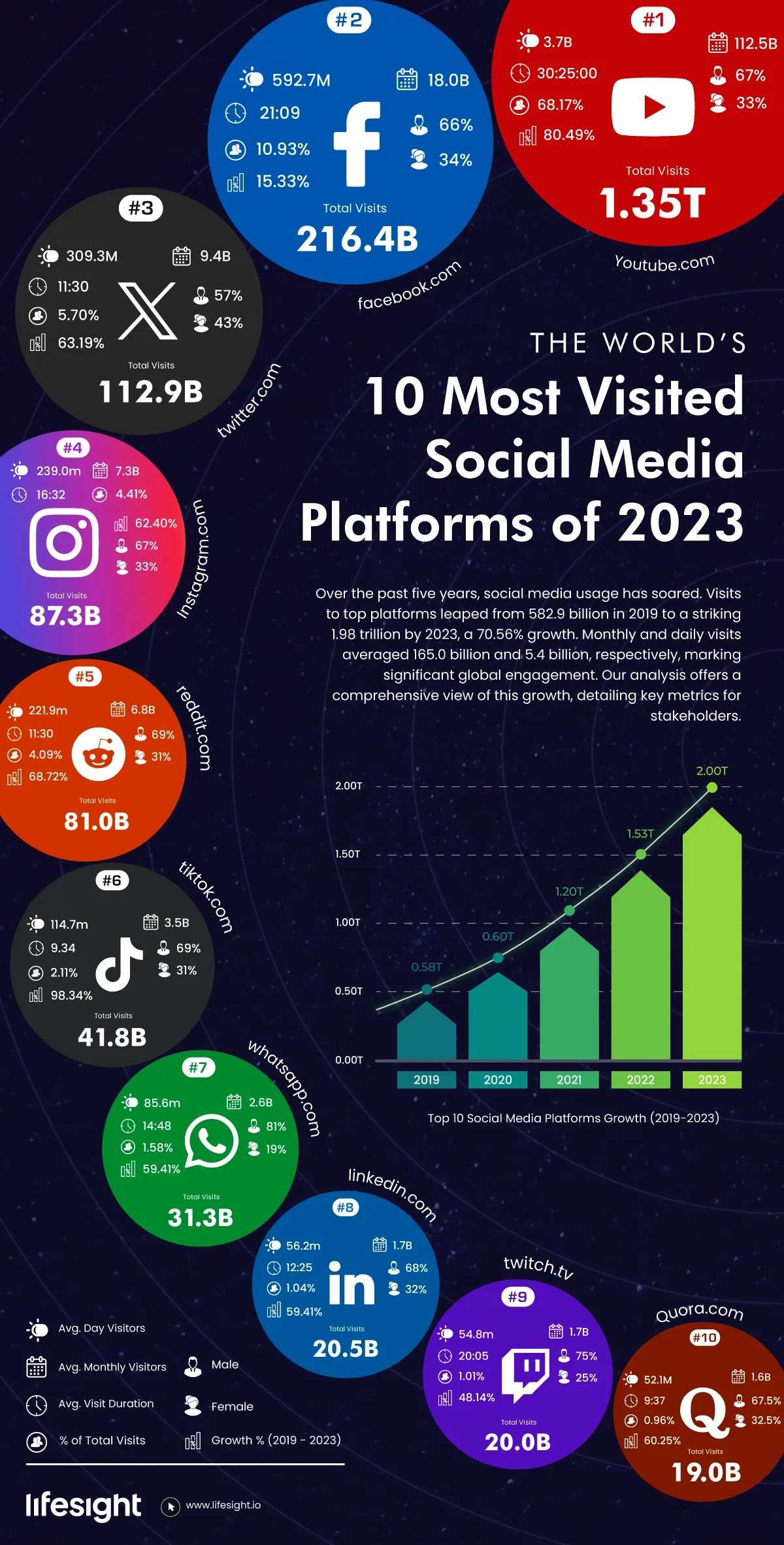Social media is a huge part of our daily lives. Most people use it to connect, share, and stay informed.
But which platforms lead the pack? In this blog post, we will explore the four most popular social media platforms. These platforms have changed how we interact online. From posting photos to sharing news, they offer unique ways to connect.
Understanding these platforms can help you make the most of your social media experience. Whether you are a casual user or a business looking to engage with customers, knowing where to focus your efforts is key. Let’s dive in and see what makes these platforms so popular.

Credit: www.comscore.com
Facebook remains one of the most popular social media platforms. With billions of active users, it connects people worldwide. Let’s delve into Facebook’s history, key features, user demographics, and marketing opportunities.
History And Growth
Facebook was launched in 2004 by Mark Zuckerberg. Initially, it was created for Harvard students. Soon, it expanded to other universities. By 2006, anyone over 13 with a valid email could join. Facebook’s growth was rapid, reaching 1 billion users by 2012. Today, it boasts over 2.8 billion monthly active users.
Key Features
Facebook offers a variety of features:
- News Feed: Displays posts from friends and pages you follow.
- Messenger: A standalone app for instant messaging.
- Groups: Allows users to create and join communities.
- Events: Organize and promote events.
- Marketplace: Buy and sell items locally.
User Demographics
Understanding Facebook’s user demographics can help tailor content. Here’s a breakdown:
| Age Group | Percentage of Users |
|---|---|
| 13-17 | 5% |
| 18-24 | 29% |
| 25-34 | 31% |
| 35-44 | 16% |
| 45-54 | 10% |
| 55+ | 9% |
Marketing Opportunities
Facebook offers numerous marketing opportunities for businesses:
- Ads: Targeted ads based on user data.
- Pages: Create a business page to share updates.
- Groups: Engage with niche communities.
- Influencer Partnerships: Collaborate with influencers to reach a wider audience.
- Events: Promote events to a large audience.
These tools make Facebook a valuable platform for businesses.
Instagram is a popular social media platform known for its visual content. It allows users to share photos and videos. This platform is widely used by individuals, influencers, and businesses. Instagram offers various features that help users connect and engage with their audience.
Evolution
Instagram was launched in 2010. Initially, it was a simple photo-sharing app. Over the years, it has evolved significantly. Facebook acquired Instagram in 2012. This acquisition brought many changes. The platform introduced new features like Stories, IGTV, and Reels. These features enhanced user engagement.
Popular Features
- Stories: Share photos and videos that disappear after 24 hours.
- Reels: Create and share 15-30 second video clips.
- IGTV: Upload longer videos for more in-depth content.
- Direct Messaging: Communicate privately with other users.
- Filters: Enhance photos with various effects.
Target Audience
Instagram’s primary users are young adults. People aged 18 to 34 are the most active. Teenagers also love using Instagram. They enjoy sharing their daily lives. The platform appeals to both male and female users. It is popular worldwide. Users from various countries engage on Instagram daily.
Business Tools
Instagram offers many tools for businesses. These tools help brands reach their target audience. Some key business tools include:
- Instagram Ads: Promote your products to a broader audience.
- Insights: Analyze your posts’ performance and audience engagement.
- Shoppable Posts: Allow users to buy products directly from posts.
- Business Profiles: Access additional features like contact buttons.
- Sponsored Content: Collaborate with influencers to promote your brand.
These tools help businesses grow their presence on Instagram. They can effectively market their products. This leads to better engagement and sales.
Twitter is one of the most popular social media platforms. It allows users to share short messages known as “tweets.” These tweets can include text, images, videos, and links. Twitter is famous for its real-time updates and trending topics.
Brief History
Twitter was created in March 2006 by Jack Dorsey, Biz Stone, and Evan Williams. The platform launched publicly in July 2006. Initially, it was an SMS-based messaging service. Over time, it evolved into a powerful social media tool. Twitter went public in November 2013, and since then, it has grown significantly.
Unique Characteristics
- Character Limit: Tweets are limited to 280 characters.
- Real-Time Updates: Users get live updates on trending topics.
- Hashtags: Users can categorize tweets using hashtags.
- Mentions: Users can tag others using the “@” symbol.
- Retweets: Users can share others’ tweets with their followers.
- Moments: Curated stories showcasing the best of what’s happening on Twitter.
Main Users
Twitter attracts a diverse user base. Celebrities, politicians, journalists, and brands use Twitter to engage with their audience. Regular users also use Twitter to stay updated and share their thoughts. Here is a breakdown of its main users:
| Category | Examples |
|---|---|
| Celebrities | Singers, actors, athletes |
| Politicians | Presidents, prime ministers, senators |
| Journalists | News reporters, media houses |
| Brands | Companies, startups, influencers |
Advertising Potential
Twitter offers several advertising options. Businesses can use Promoted Tweets to reach a larger audience. Promoted Accounts help brands gain more followers. Promoted Trends allow companies to highlight specific hashtags.
Twitter’s advertising features are designed to target specific demographics. This makes it easier for businesses to reach their ideal customers. The platform’s analytics tools help advertisers measure the success of their campaigns.
Tiktok
TikTok has become one of the most popular social media platforms. Its short video format and engaging features have captured the attention of millions. Let’s dive into why TikTok is so popular.
Rise To Fame
TikTok launched in 2016 by ByteDance, a Chinese company. It quickly gained popularity around the world. In just a few years, it became a household name. The app’s unique approach to content creation set it apart. Users loved its short, catchy videos. These videos often go viral, spreading like wildfire.
Engaging Features
TikTok offers many features that keep users hooked. The app’s algorithm shows personalized content. This makes each user’s feed unique and interesting. Users can add music, filters, and effects to their videos. These tools make content creation easy and fun. Duet and Stitch features allow users to interact with each other’s videos. This fosters a sense of community and collaboration.
Primary Users
TikTok’s primary users are young people. Most users are between the ages of 16 and 24. They enjoy the app’s fast-paced, entertaining content. TikTok has also attracted older users. People of all ages find value in its diverse content.
Brand Promotion
Brands have noticed TikTok’s massive reach. They use the platform to promote their products. Influencer partnerships are common. Brands collaborate with popular TikTok creators. This helps them reach a larger audience. Creative, engaging content performs well. It captures viewers’ attention and drives engagement. TikTok ads also offer brands a way to reach potential customers.
Comparative Analysis
Comparing social media platforms helps us choose the best fit for our needs. Each platform has unique features and user bases. This analysis will cover user base comparison, feature comparison, and marketing effectiveness.
User Base Comparison
Facebook has over 2.8 billion monthly active users. It appeals to a wide age range. Instagram has around 1 billion users, mostly younger audiences. Twitter attracts 330 million users, known for real-time updates. LinkedIn has about 740 million users, focusing on professionals.
Feature Comparison
Facebook offers diverse features like groups, events, and marketplace. Instagram shines with Stories, IGTV, and shopping options. Twitter is strong in trends, hashtags, and short messages. LinkedIn excels with job listings, professional networking, and industry news.
Marketing Effectiveness
Facebook’s ads target specific demographics and interests. Instagram’s visual appeal drives engagement, ideal for brands. Twitter’s real-time nature suits announcements and customer service. LinkedIn’s B2B focus makes it great for professional services marketing.

Credit: www.linkedin.com
Future Trends
Social media platforms are always changing. They introduce new features and adapt to user needs. Future trends in social media will shape how we interact and do business online.
Emerging Features
New features are on the rise. Some platforms now have augmented reality (AR) and virtual reality (VR) tools. These tools create immersive experiences. Live streaming is also more popular. It allows real-time interaction with audiences. AI-driven chatbots are another trend. They improve customer service by providing instant responses.
Potential Growth Areas
E-commerce integration is a big growth area. Platforms are adding shopping features. Users can buy products without leaving the app. Short-form videos like those on TikTok are also expanding. They engage users quickly. Personalization through algorithms is increasing. This makes content more relevant to each user.
Impact On Businesses
Social media trends impact businesses in many ways. Enhanced engagement tools help companies interact with customers. Targeted advertising is more precise, reaching the right audience. Data analytics tools provide insights into customer behavior. This helps in making informed decisions. Brand visibility increases with interactive content, reaching a wider audience.

Credit: lifesight.io
Frequently Asked Questions
What Are The Top 4 Social Media Platforms?
The top 4 social media platforms are Facebook, Instagram, Twitter, and TikTok. These platforms have the highest user engagement and popularity. They offer various features to connect, share, and communicate with others online.
Why Is Facebook Popular?
Facebook is popular because it connects people worldwide. It offers diverse features like news feed, groups, and events. Users can share photos, videos, and updates. Businesses also use Facebook for marketing.
How Does Instagram Attract Users?
Instagram attracts users with its visual content focus. It allows sharing photos and videos with filters. Features like Stories and IGTV enhance user engagement. Influencers and brands use Instagram for promotions.
What Makes Twitter Unique?
Twitter is unique for its real-time news and short updates. Users can share thoughts in 280 characters. It’s popular for trending topics, hashtags, and direct interactions with celebrities and public figures.
Conclusion
Exploring the top social media platforms helps you connect better. Facebook, Instagram, Twitter, and TikTok dominate the landscape. Each platform has unique features and audiences. Understanding them helps you choose the best fit. Stay updated, as trends can shift quickly.
Keep engaging with your audience for success. Social media is powerful for communication and growth. Choose wisely, and enjoy the benefits.




